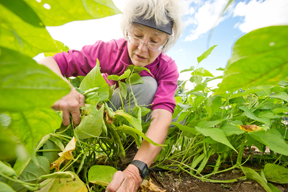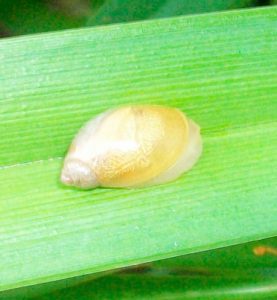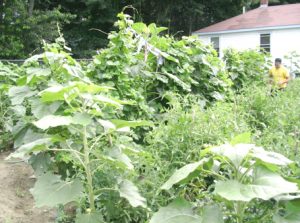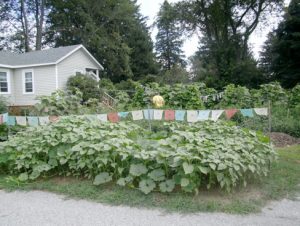Maine Home Garden News — August 2012
- August is the month to . . .
- Master Gardener Volunteer Outreach — Gardening at the Veterans’ Home
- On the Trail of the Anonymous Ambersnail
- From Lawn to Garden: South Portland Resident Donates Lawn to Hunger Relief
- 4th Annual Backyard Locavore Day
By Diana Hibbard, Home Horticulture Coordinator, University of Maine Cooperative Extension, Cumberland County, dhibbard@maine.edu.
- August is: asters, goldenrod, corn, squash, tomatoes and the 2nd cutting of hay
- August is: early apples, peaches and peas
- AUGUST BEGINS THE HARVEST!
- Pick up news gardening ideas and tips by visiting public gardens or parks in your area. Garden clubs and groups often arrange tours of some of their best gardens.
- Harvest your garlic saving the best heads for replanting in October. Wait for the bottom 2 or 3 leaves to turn yellow. Watch our video below or see Growing Garlic from University of Vermont Extension
- Dig your potatoes. New potatoes are delicious. Further tips for growing potatoes in your garden next year can be found in Bulletin #2077, Growing Potatoes in the Home Garden.
- Water newly planted shrubs and trees. It is essential they have enough moisture going into the winter. See Bulletin #2366, Selecting, Planting and Caring for Trees and Shrubs.
- As areas in your garden become empty, amend your vegetable garden soil by sowing cover crops. These green manures will be turned under to improve the soil tilth and fertility.
- Sow another crop of peas, collards, kale, and brussel sprouts. Extend the season with successive plantings. See all the ways you can get your garden going earlier in the spring and later into the fall in Bulletin #2752, Extending the Gardening Season.
- Fertilize peonies. Peonies prefer full sun. Wait until frost damages the foliage before cutting down. Peonies do not need to be divided often, but if you need to move them fall is the best time. Don’t plant them too deep to assure a good bloom.
- Check out the Plant Hardiness Zone Map for Maine. The success of perennial plants depends on many factors, including temperature, light levels, light duration, and soil, water, oxygen and nutrients. Bulletin #2242, Plant Hardiness Zone Map of Maine.
- Pay attention to your lawn. This is the best time of year to plant and reseed. Bulletin #2367, Establishing a Home Lawn in Maine.
- Try a “low-mow” grass to decrease your mowing. For more information, see Bulletin #2166, Steps to a Low-Input, Healthy Garden.
- Pick tomatoes and make spaghetti sauce and salsa and all your favorite dishes. Keep the plants healthy by watering regularly in the early morning and continue to fertilize every 2 weeks. Cut the tops off your indeterminate tomatoes sending energy to help the fruit mature and grow larger. Bulletin #4085, Let’s Preserve Tomatoes.
- Buy fall mums. They can add color to those empty spots in the perennial garden. Or pot them up for your deck or front porch.
- Feed the hungry! Sign up for Maine Harvest for Hunger and donate your excess produce. See Bulletin #4303, A Donors Guide to Vegetable Harvest.
- Sign up for the 4th Annual Backyard Locavore Day in Cumberland County scheduled for August 11th (Rain date: August 12th). This educational event, provided by University of Maine Cooperative Extension’s Master Gardeners and Master Food Preservers, will showcase sustainable ways to increase self-sufficiency to meet your own food needs. Demonstrations will focus on backyard gardening techniques, food preservation methods, and more.
Master Gardener Volunteer Outreach — Gardening at the Veterans’ Home
By Barbara Murphy, Extension Educator, University of Maine Cooperative Extension, Oxford County, barbara.murphy@maine.edu.
As a Master Gardener Volunteer program coordinator, it is my job to connect Master Gardener Volunteers with thoughtful, worthwhile projects that utilize their gardening skills. Finding activities with the right mix of education, outreach, fun, and volunteer satisfaction can be quite challenging, especially in rural Oxford County. So, when an opportunity came to create a vegetable garden at the local, residential Veterans’ Home, it seemed like something to explore further.
Four years ago I was contacted by the activities director at the VA home to answer some questions that a resident had about blueberries. As it turned out, I knew the resident, Norm, when he grew prolific blueberries in Bethel. The director of the Veterans Home had given Norm permission to plant a dozen blueberries on the property and he was eager to get going. Once the blueberry plants were in and established, Norm then focused on creating a vegetable garden on the extensive grounds, one where able residents could participate or at least enjoy from their windows or as they stroll along the garden path.
To get the process rolling, I met with the director, the head of grounds and landscaping, the activities director, and kitchen manager to listen to their concerns about maintenance, cost, and participation. It was agreed to start small, 10’ x 20’, and that the VA would pay for costs of soil amendments and seeds, and provide access to water. Master Gardener Volunteers would plan, plant, maintain, and harvest the garden, and bring the harvest to the kitchen. Residents of the facility were encouraged to participate (some even attended planning meetings) as much as their physical abilities allowed.

Since 2010, the Oxford County Master Gardeners have been tending the Veterans’ Home garden. Lots of different crops have been tried, but now the focus is on residents’ favorites such as tomatoes, peppers, cucumbers, lettuce, eggplant, winter squash, beets, onions, and zucchini. To accommodate all of the vegetables, the garden was enlarged to 10’ x 30’ last year. Initially our hope was that residents would participate in the garden work, but few have the ability to work on a ground-level garden. However, there are plenty of raised beds, whiskey barrels, and wheelchair accessible garden beds around the facility to keep all who are interested up to their elbows in soil. Lack of physical participation does not mean that the residents are not interested in what is happening at the garden. What is magical about the Master Gardener garden is the opportunity it provides for residents, their families, and visitors to talk with the volunteers while they garden, to reminisce about their gardening experiences or to offer an opinion about what should be done next. Recent comments show that the garden is appreciated. One resident told a gardener, “I’m so glad you’ve continued with the garden; I walk by it every day to see how it’s doing.” Another man said, “I never gardened at home, but my wife always had a nice big garden. This makes it seem more like home for me.”
If you are thinking about starting a gardening project at a veterans’ center, here are some things we learned:
- Meet with the leadership at the veterans’ center regularly while the plans are being put together.
- Make sure there is a long-term maintenance plan in place. Who will be tending the garden three, five, and ten years from now?
- Make the garden as accessible as possible — wide rows and beds and, if finances allow, raised beds.
- Don’t be discouraged if no one actively participates in the garden. Over time we have learned that people enjoy the garden in many ways — showing it to friends and family, keeping track of how much is being grown, talking to the gardeners, enjoying the harvest in a meal.
- Put a sign in the garden letting everyone know that the garden is there for all to enjoy and snack on.
Our small garden is not a burden to maintain, it provides a worthwhile volunteer experience, and gives pleasure to the residents of the facility — a definite win for everyone.
On the Trail of the Anonymous Ambersnail
By Craig Anthony, Home Horticulture Coordinator, UMaine Extension, Piscataquis County, craig.anthony@maine.edu.

I first became aware of an unidentified ambersnail this past June, when I awoke each morning to find that my eggplant seedlings disappearing one by one. A warrant was issued for the usual suspects to be brought in for questioning, but none quite fitting the description were found in my garden’s jurisdiction. Then, one sunny morning, I came across a likely suspect innocently seeking refuge on the shady side of one of the container plants.
When I arrived at work that day, I came across twenty to thirty members of the same suspicious gang resting beside the raised bed demonstration garden at the UMaine Extension Piscataquis County office. My supervisor mentioned that she had never seen these snails in the garden before this summer. Again, there were tell-tale signs of vandalism in the garden, yet all of the suspects were relaxing peacefully under the shade of the Mountain Ash tree in their daylily hammocks.
I soon learned that there had been sightings of suspects all over the state — Downeast and all over central Maine. Clay Kirby, University of Maine Cooperative Extension Insect Diagnostician, reported that, “I have been seeing this snail all over the place for the past several years. I’ve seen it in the boonies along the Machias river years ago and in my back yard. It’s got a soft shell. It is probably an ambersnail.”
I had my first ID on the perp, but exactly which ambersnail was it? It has done so well at remaining ordinary that ascertaining its true identity remained a mystery. It became apparent that a thorough investigation was necessary to create a more comprehensive profile of the garden marauder, so we did not, in fact, implicate an innocent garden denizen.
An inquiry to Jeanie L. McGowan, Director of the Nylander Museum of Natural History in Caribou, ME, revealed:
“Yes, it looks like one of the Succinea species to me also. And I agree we are seeing large numbers of these in many areas in Maine. I’ve gotten calls from Downeast and I see them all over central Maine. Unfortunately we’ve never found anyone who can identify which species we’re seeing and whether they are native or introduced. In our collections there is mention of the following specimens that may be your find:
- Succinea ovalis Gld. Aroostook County, ME.
- Succinea obliqua Say. Woodland. Common everywhere
- Succinea avara Say. Common in wet places on lake shores
Nylander documents NYW-0028 (1895) and NYW-0031 (1900)
Fellow malacologist Scott Martin added: There have been six species of Succineid land snails reported from Maine, but probably 2-3 are questionable. Your snail pictures mostly look yellowish-gold to me, which I would ascribe to the common Novisuccinea ovalis, or oval ambersnail, which has been reported from all 16 of Maine’s counties. Catinella vermeta is usually brownish, while Oxyloma retusa is longer and often more inflated at the opening. Technically, you’re supposed to do dissections of the reproductive parts to verify the ID of succineids, but this can be problematic even for the experts, as the reproductive system does not necessarily look the same throughout the year (and the sex might even change).
The plot thickened when Ken Hotopp, conservation biologist with Appalachian Biology of Bethel, ME, observed: “You are right that it is a type of ambersnail, Family Succineidae. The snail looks like Succinea putris, an introduced European species. There is one native species that size — Novisuccinea ovalis — but it tends to have whorls that are little more “inflated” so it’s less sleek-looking. S. putris tends to become abundant in summertime in parks, gardens, nurseries, and agricultural areas, sometimes along river floodplains. It gets introduced on plants, shrubs, and probably mulch and landscaping materials.
So for now, it remains an open case until further evidence comes in, but I would have to agree that the suspect is most likely Succinea putris. We had recently purchased bark mulch for the office garden and it had been very wet early this summer, which may account for its sudden appearance at the office garden, but not necessarily for the other sightings.
As for control, the damage was minimal and the snails have all but disappeared in the hotter weather. Some management ideas were generated, but untested, including using slug controls such as iron phosphate baits, mowing or creating barriers of crushed stone or other materials that will slow them down on their way to the garden, or even a “prescribed burn” if the snails are in a limited area.
Clearly, more research is necessary to learn more about this particular ambersnail, why we are seeing such an abundance of them now, and how best to manage their numbers in the future. This writer requests more information from individuals who have encountered this species of ambersnail for a possible follow-up article.
From Lawn to Garden: South Portland Resident Donates Lawn to Hunger Relief
By Don Morrison, University of Maine Cooperative Extension Master Gardener Volunteer, Cumberland County, DMorrison@waysidemaine.org.
Last April, South Portland resident Liberty Bryer had a lush green grassy lawn, the American homeowner’s dream. And then she decided to do something about it. Working with staff and volunteers from Wayside Food Programs in Portland, and Cumberland County Master Gardeners, Bryer tore up the lawn and planted a garden. Where the lovely, though unproductive, lawn once was, now lies a tangle of overflowing tomato plants, tripods of creeping, climbing pole beans, towering sunflowers, and bushy herbs. The produce grown in the garden is being harvested by volunteers and used in Wayside’s hunger relief efforts at its free community meals and mobile food pantries.
Bryer approached Wayside volunteer coordinator Carly Milkowski after learning about a similar garden project in Cumberland that had fallen through due to the sale of the land. Having recently bought a home in South Portland after moving to Maine from the U.S. Virgin Islands, Bryer was looking for something productive to do with her land, which gets full sun and seemed like a perfect place to garden.
“We literally tore up Liberty’s entire lawn,” says Milkowski. “It felt a little crazy at first, trying to kill the grass by laying down cardboard, and then crawling around digging out clumps of sod. I don’t know what the neighbors thought at that point, but they were all willing to lend a hand or some tools, and now we have this beautiful garden and food coming out of it that’s been grown with a lot of love to help the community. It’s been an amazing experience.”
The garden project has been made possible by generous donations of time, tools, and seeds by Town and Country Federal Credit Union, Tammaro Landscaping, and Broadway Gardens. Volunteers from Learning Work’s Youth Building Alternatives help out on a weekly basis, weeding, turning compost, and keeping the Japanese beetle population under control. Many other community volunteers have also donated their time.
# # #
Wayside is currently in its 25th year of increasing access to nutritious food for people in southern Maine. Wayside’s hunger relief efforts include five free community meals sites, four mobile food pantries, a kids’ healthy snacks program, family summer meals and two community gardens. Through its Food Rescue Program, Wayside recovered 1.8 million pounds of food in 2010. The rescued food is distributed to more than 60 agencies throughout Cumberland County, including food pantries, soup kitchens, and shelters. For more information please visit us at www.waysidemaine.org or www.facebook.com/waysidefoodprograms.
4th Annual Backyard Locavore Day
Saturday, August 11, 2012, 10 a.m. – 4:00 p.m.
Rain date: Sunday, August 12, 2012

This educational event, provided by University of Maine Cooperative Extension’s Master Gardeners and Master Food Preservers, will showcase sustainable ways to increase self-sufficiency to meet your own food needs. Demonstrations will focus on backyard gardening techniques, food preservation methods, and more.
University of Maine Cooperative Extension’s Maine Home Garden News is designed to equip home gardeners with practical, timely information.
Let us know if you would like to be notified when new issues are posted. To receive e-mail notifications fill out our online form.
Contact Colleen Hoyt at colleen.hoyt@maine.edu or 1-800-287-1471 (in Maine).
Visit our Archives to see past issues.
Maine Home Garden News was created in response to a continued increase in requests for information on gardening and includes timely and seasonal tips, as well as research-based articles on all aspects of gardening. Articles are written by UMaine Extension specialists, educators, and horticulture professionals, as well as Master Gardener Volunteers from around Maine, with Professor Richard Brzozowski serving as editor.
Information in this publication is provided purely for educational purposes. No responsibility is assumed for any problems associated with the use of products or services mentioned. No endorsement of products or companies is intended, nor is criticism of unnamed products or companies implied.
© 2012
Published and distributed in furtherance of Acts of Congress of May 8 and June 30, 1914, by the University of Maine Cooperative Extension, the Land Grant University of the state of Maine and the U.S. Department of Agriculture cooperating. Cooperative Extension and other agencies of the U.S.D.A. provide equal opportunities in programs and employment.
Call 800-287-0274 or TDD 800-287-8957 (in Maine), or 207-581-3188, for information on publications and program offerings from University of Maine Cooperative Extension, or visit extension.umaine.edu.


